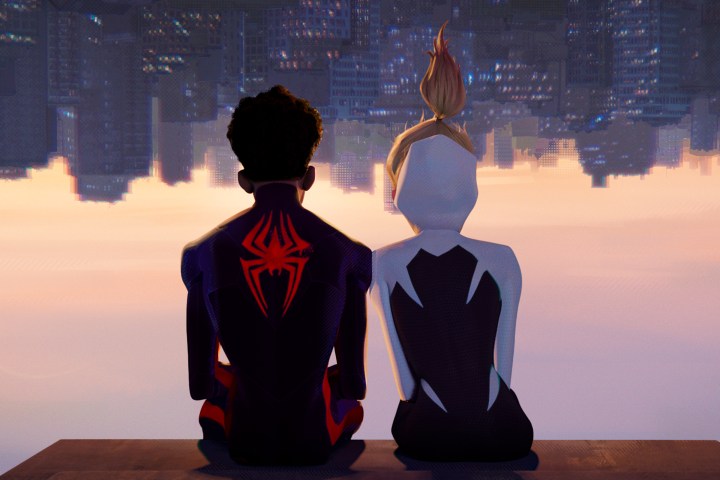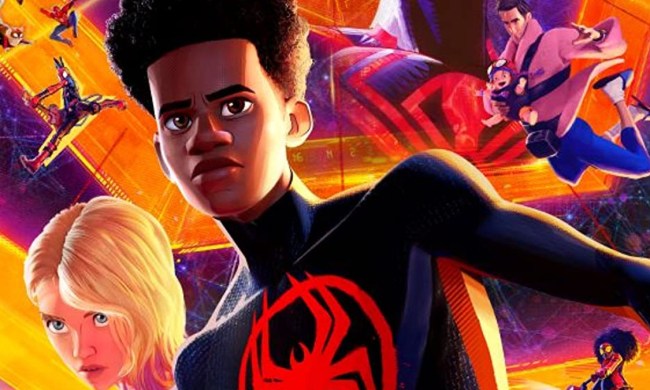“Spider-Man: Across the Spider-Verse is a bold, colorful blockbuster that raises the bar for all the superhero films that are set to follow it.”
- Stunning animation throughout
- A cast of compelling characters
- Endless visual experimentation
- A slightly unsatisfying ending
You’ve never seen a movie quite like Spider-Man: Across the Spider-Verse. Even its predecessor, 2018’s Spider-Man: Into the Spider-Verse, seems a bit quaint in comparison to the new film. It’s not Across the Spider-Verse’s plot that makes it all that unique, either. In a time when multiversal tales are all the rage, the film’s story feels unavoidably similar at times to those told in recent titles like Doctor Strange in the Multiverse of Madness and Spider-Man: No Way Home. But none of the Marvel movies or TV shows that have come before it have been able to capture their viewers’ attention or ignite their imaginations quite like Spider-Man: Across the Spider-Verse does.
The film is an atomic, rainbow-colored blast of pure wonder. It’s a superhero blockbuster that experiments with the form of animation in such consistently awe-inspiring ways that it’s impossible not to be overwhelmed by the sheer scope of the artistry on display throughout its admittedly long 136-minute runtime. It’s a film that invites multiple rewatches not just because of the intricacies of its plot and the depth of its characters, but because of all of the little details and secrets featured at the very edges of every one of its immaculately drawn frames, which demand to be noticed and seen.
Not since Into the Spider-Verse has a big-screen comic book adventure felt this interested in playing with the actual medium of cinema. To put that another way: It’s been a long time since a superhero movie has felt this alive, this vibrant, and this vital.

Like all great sequels, Spider-Man: Across the Spider-Verse builds on the tricks of its predecessor. The film takes the multi-perspective structure that Into the Spider-Verse toyed around with and fully adopts it. This time, viewers aren’t just invited to see the continuation of Miles Morales’ (Shameik Moore, The Get Down) story, but also Gwen Stacy’s (Hailee Steinfeld, Hawkeye). Both stories are, in typical Spider-Man fashion, shaded in the tragedy of their respective, personal losses. More than anything, though, what’s truly striking about Gwen and Miles’ stories in Across the Spider-Verse is just how lonely both are when the film picks back up with them.
As Gwen’s opening narration reveals, the loneliness that comes with her and Miles’ vigilante lives has only been amplified by their interactions with each other in Into the Spider-Verse. Now that Gwen and Miles know they’re not only the ones in the multiverse who know what it’s like to be a friendly neighborhood web-slinger, they’re both desperate to recapture that feeling. It’s that desperation that leads Gwen to so eagerly join up with Jessica Drew/Spider-Woman (Issa Rae, Insecure) and Miguel O’Hara/Spider-Man 2099 (Oscar Isaac, Moon Knight), a pair of commanding multiversal web-slingers, in Across the Spider-Verse’s predictably action-packed, surprisingly melancholic prologue.
With the help of some technology provided by Miguel, Gwen inevitably finds her way back to Miles’ universe. Their flirtatious, lovelorn reunion is cut short, however, when a mission to capture and contain a bumbling but nonetheless dangerous villain known as The Spot (Jason Schwartzman, Asteroid City) goes awry. When Miles consequently finds himself on a multiversal journey with Gwen to stop The Spot, he not only meets more alternate versions of Spider-Man than he ever knew existed but also ends up coming to philosophical and physical blows with Isaac’s Miguel. As visually exciting as it is to see different versions of Spider-Man combat each other on-screen, too, Across the Spider-Verse never loses sight of its characters and their journeys.

Miles’ conflict with Miguel and his sacred Spider Society opens the door for Across the Spider-Verse’s script, which was penned by Phil Lord, Chris Miller, and Dave Callaham, to explore complex emotional ideas. Across the Spider-Verse is fittingly compelled by the notion of one’s personal sense of responsibility, and not just to the world at large, but also to those who are closest to us. These themes, combined with the film’s focus on Miles and Gwen’s existing familial relationships, allow Across the Spider-Verse to slowly but surely build a shockingly rich tapestry of emotions within its story.
The expansiveness of its story is visually reflected throughout the film, which sees Joaquim Dos Santos, Kemp Powers, and Justin K. Thompson taking over for Into the Spider-Verse directors Bob Persichetti, Peter Ramsey, and Rodney Rothman. Over the course of its runtime, Across the Spider-Verse bounces between so many different art styles and forms of animation that the film might feel visually messy were it not for the fact that every world and character introduced in it looks and feels fully imagined. This writer was particularly enamored with the watercolor-esque, pastel-heavy way in which Gwen’s home universe is brought to life. Not only is Gwen herself drawn in different shades of green, blue, and pink every time she travels home in the film, but the colors of the environments around her constantly bleed together.
The film’s various forms of animation help lift up even its most tangential of detours. One trip to Mumbattan, the home of Pavitr Prabhakar/Spider-Man India (Karan Soni), goes on a bit too long and feels like one of Across the Spider-Verse’s least necessary sequences, but it’s such a joy to watch that its superfluousness doesn’t matter all that much. The vibrancy of Mumbattan, combined with the humor that’s immediately established between Pavitr, Gwen, and Miles, makes it easy to get caught up in the characters’ antics — even when there are moments throughout the sequence when Across the Spider-Verse’s plot becomes a bit too convoluted for its own good.

As strange as the comparison may initially seem, the film that Across the Spider-Verse most strongly calls to mind is Denis Villeneuve’s Dune. Like that sci-fi epic, Across the Spider-Verse is an immaculately built construction, one that’s overflowing with more vividly-realized ideas, characters, and images than it knows what to do with. Unfortunately, like Dune, Across the Spider-Verse also tells just half of its story. The film pointedly ends with the promise that its plot will be wrapped up in Spider-Man: Beyond the Spider-Verse, which is already slated to hit theaters next March.
The good news is that Across the Spider-Verse is such a lovingly made, astonishingly effective sensorial experience that its power isn’t diminished much by the fact that it’s ultimately an appetizer. It’s a superhero adventure film that cares just as much about its characters and their struggles as it does the visual possibilities of its medium. By the time it’s come to an end, the film has managed to do the impossible: breathe new life into a genre that had begun to feel increasingly lifeless as of late. Odds are, you’ll likely leave Across the Spider-Verse feeling a little rejuvenated yourself.
For the first time in a long time, Hollywood has delivered a superhero movie that’ll actually leave you hungry for more.
Spider-Man: Across the Spider-Verse is now playing in theaters. For more related content, be sure to check out Across the Spider-Verse’s ending explained, is there a post-credits scene in Across the Spider-Verse, and all the Easter eggs in Across the Spider-Verse.




